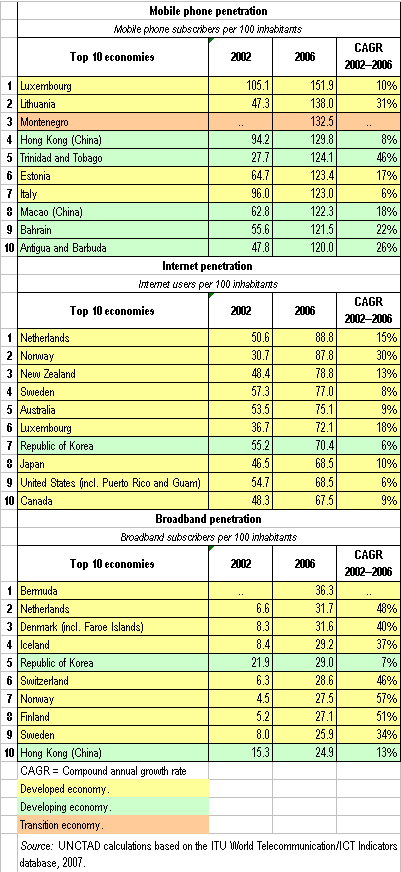| EMBARGO The contents of this press release and the related Report must not be quoted or summarized in the print, broadcast or electronic media before 6 February 2008, 19:00 GMT |
Most developing countries remain far behind industrialized nations in availability, use of information and communication technology
The diffusion of information and communication technology (ICT) in developing countries is growing, but except for East Asian nations that straddle the line between "developed" and "developing" status -- notably the Republic of Korea and Singapore -- such countries lag far behind the industrialized world in the application of ICT and its use by businesses, a new UNCTAD report says.
A chief obstacle is lower rates of access to broadband Internet service, which allows forms of rapid communication, e-finance and e-banking that greatly increase business productivity and efficiency, the Information Economy Report 2007-2008 (1) notes.
Among the forms of ICT, mobile phones are most widely used in developing countries. Mobile phone subscribers have almost tripled in such nations over the last five years, and now make up some 58% of mobile subscribers. Developing countries in Asia and Africa had the highest growth rates in mobile phone penetration worldwide. For example, from 2005 to 2006, the number of mobile phone subscribers in Nepal grew from 1% to 4% of the population, while in Ghana growth was from 8% to 23%. "M-commerce," the buying and selling of goods and services using wireless handheld devices, is expanding. And the climbing use of mobile payments and banking are likely to bring growth to m-commerce, provided there is an enabling regulatory environment.
Internet use and penetration continues to increase around the world, the report says, but developed countries still account for the majority of Internet users and have the highest penetration. In 2002, Internet availability in developed countries was 10 times higher than in developing countries; in 2006, it was 6 times higher. Countries with economies in transition had the highest compound annual growth rate in Internet penetration between 2002 and 2006. Belarus and Croatia have higher Internet penetration rates than several developed countries, at 57% and 35% respectively. Several developing countries are taking active steps to expand Internet use through policies to improve ICT access and skills, regulatory reforms to increase competition and the availability of services at competitive prices, investments in ICT infrastructure, and encouragement of production in the ICT sector.
While available data show that the number of broadband Internet subscribers has grown rapidly worldwide, developed countries still account for the predominant share of subscriptions, and the gap with developing countries in terms of broadband penetration has widened since 2002. Seven of the top 10 countries in terms of broadband penetration were in Europe, and two (Republic of Korea and Hong Kong, China) are exceptions among developing countries in terms of their level of ICT diffusion. Broadband access to the Internet enables the adoption of applications that have beneficial impacts on business productivity, and because of the fast-changing technology it is important for developing countries to catch up, the report says.
The use of ICT for business can greatly contribute to income generation and can increase the productivity of enterprises. On average, 34% of European enterprises have automated integration of internal business processes. However, wider adoption of ICT by developing country enterprises is still very limited: few firms have intranet or extranet, which are often the first steps towards the automated integration of business processes. For example, an enterprise can use ICT to manage its supply chain. By improving information sharing with its suppliers, including through systems that allow for automatic replenishment, a business can maintain optimum inventory levels. Faster and more comprehensive communication enables firms to make more accurate production plans and sales forecasts in the short and long term.
To illustrate the beneficial use of ICT by firms in developing countries, UNCTAD and the Thai National Statistical Office jointly conducted the first analysis in developing countries that assesses quantitatively the impact of ICT use on labour productivity in manufacturing by small and medium-sized enterprises (SMEs).
The study found that use of ICT by Thai enterprises is associated with significantly higher sales per employee. Unlike in developed countries, the use of basic ICTs -- such as the basic employment of computers -- can account for large differences in labour productivity. Variations in the intensity of computer use in Thailand were reflected in large productivity differentials between firms. A 10% increase in the share of employees using computers was associated with 3.5% higher labour productivity (compared with 1.8% in the case of Finnish firms). Internet access and website presence were found to be correlated with higher sales per employee in Thailand, with a coefficient similar to those found in developed countries: an increase of from 4 to 6% for Internet use in Thailand, compared with an increase of 5% in the United States.
The Thai example confirms the hypothesis that enterprises in developing countries can benefit as much as businesses in developed countries from the use of ICT, the report says.
The analysis used in the UNCTAD-Thai study can be applied in other developing countries provided that the necessary data and information are available, the report notes. The Thai study is part of a broader global initiative, the UNCTAD XI Partnership on Measuring ICT for Development. The Partnership aims to improve ICT measurement and the quality of data on ICT uptake in developing countries.
ANNEX
Tables and figures
Table: Top 10 economies, mobile phone, Internet, broadband, 2002-2006
Source: UNCTAD calculations based on the ITU World Telecommunication/ICT Indicators database, 2007.


